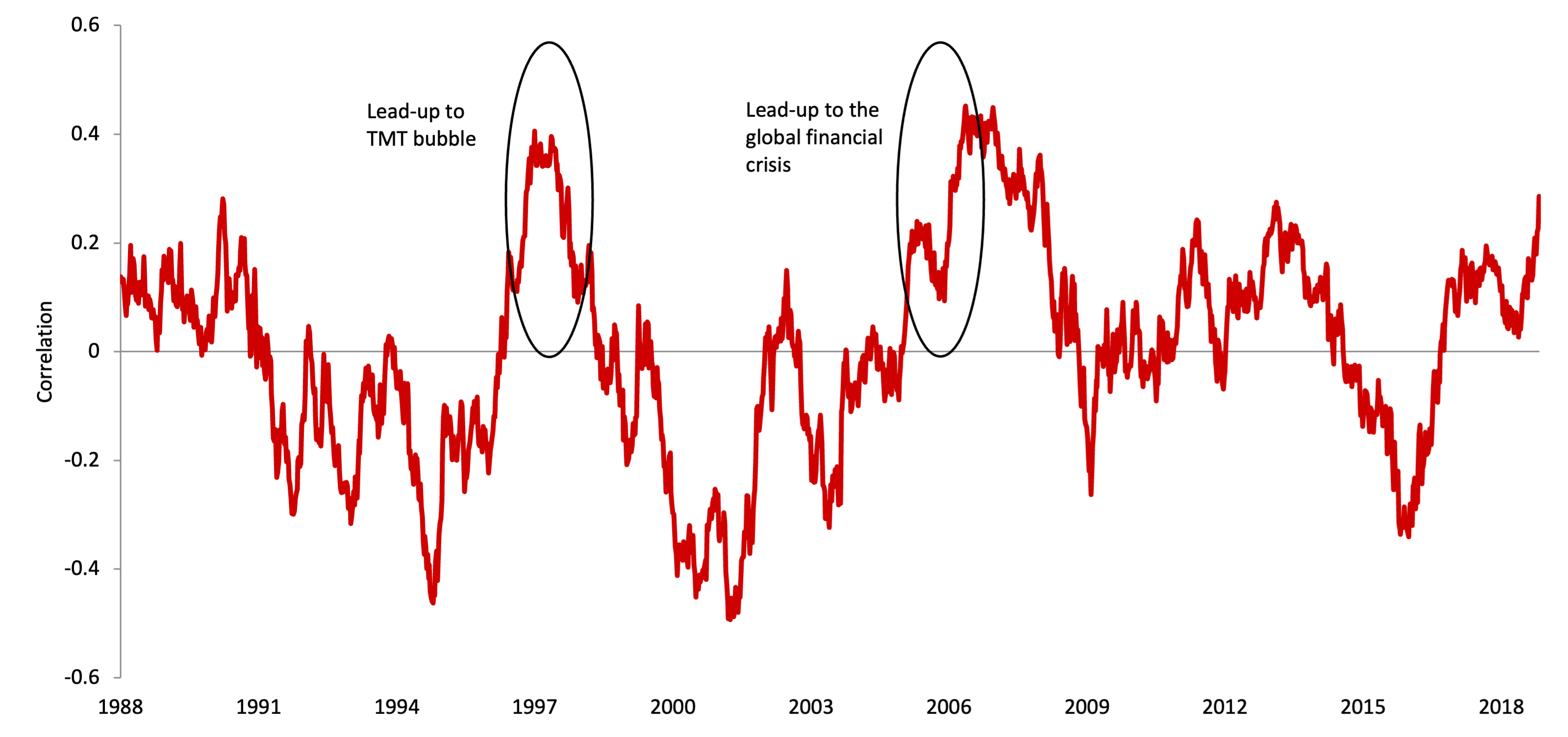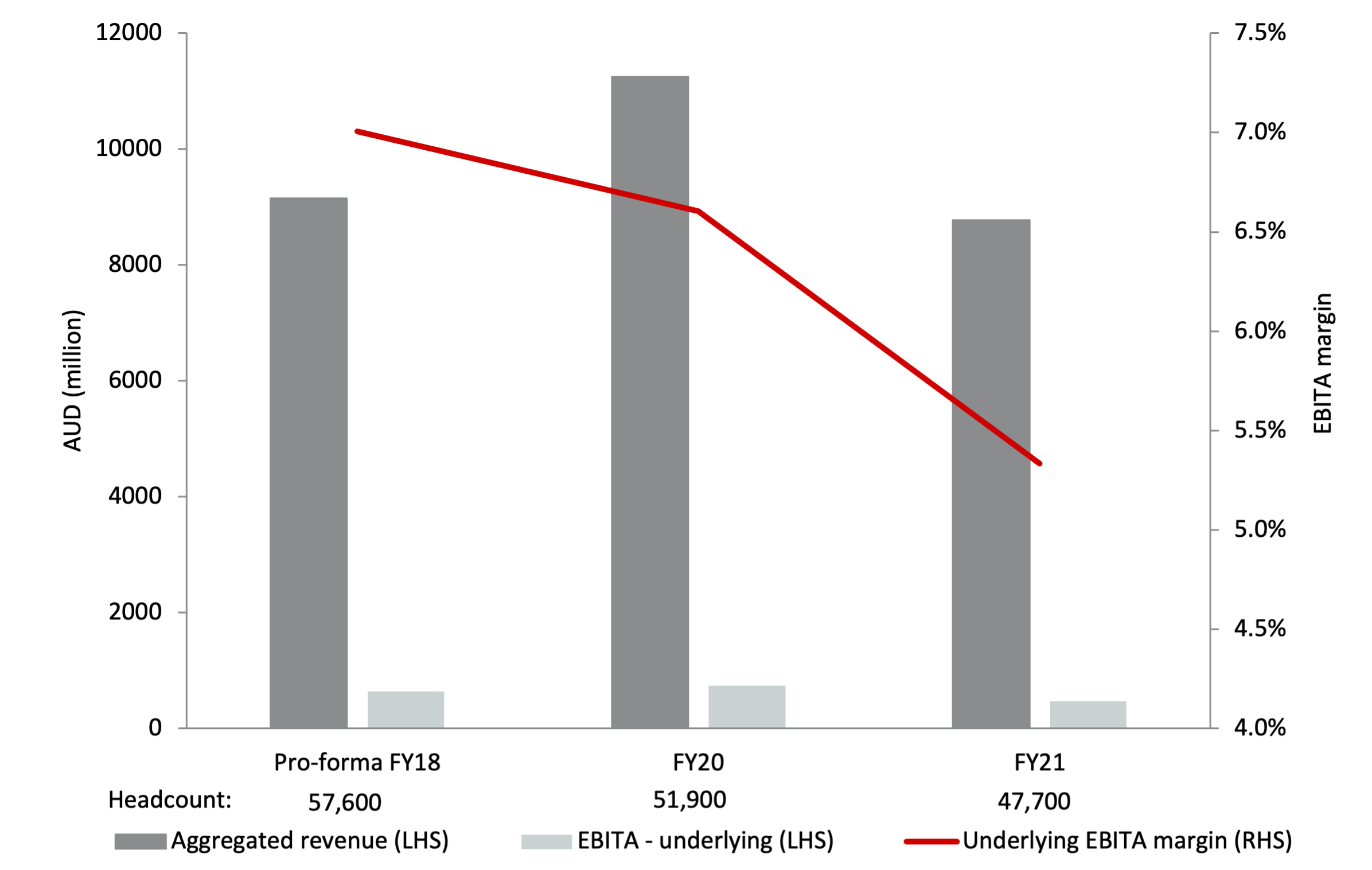Picking winners that the crowd is ignoring
Sharemarkets around the world have been trending very strongly. The winners (best performers) have been high-quality companies, stable earners and ‘sexy’ disruptors. The losers (worst performers) are mostly cyclically-exposed and ‘boring’ companies with uncertain futures.
Graph 1 illustrates the degree to which share prices have trended in recent years. It graphs the correlation between the total return of the winners over three years and the winners over the next three years. At each point on the graph, index constituents are ranked from one (the best performer in the S&P/ASX 300 Index over the prior three years) to 300 (the worst performer in the index over the prior three years). A similar rank is assigned to companies based on their actual returns in the next three years and the correlation of the ranks are determined. The higher the correlation, the greater the trending or momentum in the market.
In other words, a high correlation suggests that the winners of the past three years go on to be the winners of the next three years.
The simple way to explain the graph is to say that when the line is high, the preceding three-year share price winners continue to be the next three-year share price winners. When the line is below zero, previous winners are recent losers.
Graph 1 - Share prices are trending – winners keep on winning

Source: Orbis
The graph ends in 2018, as we don’t yet know how the 2019 cohort of winners has performed over the subsequent three years. We will only know this next year. The most recent three-year correlation is not as high as in the lead-up to the TMT bubble of the late 1990s, nor is it as high as levels immediately before the global financial crisis. But it is not far from those levels and it is higher than at every other point in time since 1988.
Should you be worried?
Is this cause for concern? We believe so. You might argue that in today’s technology-enabled age of disruption, the winners of the recent past are likely to continue to gain an increasing share of their respective markets. Think of Alphabet (Google), Meta Platforms (Facebook), Apple, Amazon, Tesla and so on.
In the absence of regulatory intervention, it is quite likely that they will continue to dominate their respective fields and win an increasing share of wallet.
Their share prices may therefore continue to reflect their respective paths to world domination.
But the vast majority of the winning technology companies in Australia are in fact the same as the ones mentioned above and none of them are listed on the Australian Securities Exchange and don’t affect our analysis. Also, even if we are wrong and a handful of Australian companies go on to dominate the world stage (as Afterpay seems destined to do), it is unlikely to impact our analysis significantly, given it is a unit-weighted analysis and agnostic about the size of each company. The degree of trending is therefore skewed by the number of companies trending rather than the market capitalisation of a few companies that have been spectacularly successful (e.g. CSL).
The risk that this has become unsustainable is growing by the day
COVID-19 is unlikely to be the cause of this trending, given the trending started before COVID’s onset. ESG considerations have likely played some role here. Whatever the reason, the risk that this has become an unsustainable feeding frenzy grows by the day. The winners continue to attract increasing amounts of investment flows, with the losers being sold to fund the buying. Price movements are the only way to balance the scales, with underlying fundamentals becoming less and less relevant.
More important than why this has happened, is how we can seek to profit from it for our clients. In the dust left behind all this momentum-driven euphoria are a number of companies we consider to be cheap and have excellent prospects. Worley Limited is one such company, which our Portfolio Manager, Dr Suhas Nayak, discusses below.
Worley Limited (ASX: WOR)
Worley is an engineering services provider that primarily services the global resources and energy sectors. Graph 2 shows the geographic and sector spread of the company’s revenue.
Graph 2: Geographic and sector spread of Worley’s revenue

Source: Worley FY21 results presentation
Worley’s engineers are typically billed out to clients (doing ‘reimbursable work’, to use industry jargon), with very little done on a lump-sum or fixed-cost basis. As a result, the company will do well if they maintain a high level of utilisation of its staff and a high level of revenue. A lot of Worley’s revenue is ‘booked and burned’ (i.e. projects are won and executed) within the year, which makes visibility of future revenue quite difficult. However, activity levels in the resources and energy sectors do influence the company’s overall revenues. Higher capital expenditure programs in both sectors will typically mean higher revenues for Worley, and, if utilisation is kept high, then that will lead to higher profits for shareholders of the company.
What went wrong?
In 2018, Worley made its biggest acquisition to date, the Energy, Chemicals and Resources (ECR) segment of Jacobs Engineering, which just about doubled the size of the company on most metrics. The share price weakened after this large acquisition, probably as a result of the change in business mix and the large issue of new shares used to fund it. While integration of the two businesses has appeared to have gone well, the aftermath of COVID-19 created significant share price weakness. COVID-19 led to the company’s major customers deferring capital expenditure and projects, which led to a sudden reduction in revenue for Worley.
While many of the underlying commodity prices have bounced back to pre-COVID-19 (or higher!) levels, capital expenditure by Worley’s clients has not kept pace.
Worley’s revenue growth has therefore lagged the underlying commodities’ price growth. Despite cost-outs that came with integration, and further cost-savings the company has made since, the lower revenues have led to a material reduction in profits as can be seen in Graph 3, which shows Worley’s pro-forma (hypothetical) financials for financial year (FY)18 (which combines ECR and Worley as if the acquisition had happened in FY18) and financials for FY20 and FY21. This has been accompanied by a sharp drop in personnel, from 57,600 in FY18 to 47,700 at the end of FY21. Please note that there is no data available for FY19.
Graph 3:Worley's profits are lower

Source: Worley Company announcements
A mix of old and new
In the past, and certainly before the ECR acquisition, Worley’s share price was highly correlated with the price of oil. This probably reflected the company’s exposure to capital expenditure by major oil and gas companies around the world. That level of correlation is less justifiable today, as the ECR acquisition diversified the business.
More recently, the company has put a much greater focus on sustainability projects, knowing that a more sustainable world is likely to involve very large capital expenditure and some complex engineering problems.
While it is possible that oil and gas capital expenditures do not grow much from the low levels of 2021, Worley’s future revenue growth may not be hindered by that one sector. The company recently flagged its aspiration for 75% of its revenue to be generated from sustainability-related business within five years.
What is priced in and what isn’t?
Worley’s current market capitalisation is $5.6b. Together with net debt of $1.5b, the company’s enterprise value is around $7.1b. This means the company currently trades at 15 times FY21 underlying earnings before interest, taxes, and amortisation (EBITA), in line with the broader market. However, we think future EBITA is likely to be significantly higher because:
- Oil and gas capital expenditure was very depressed over FY21. Low oil prices caused project deferrals across the oil and gas space.
- Work could not be done easily at many sites due to COVID-related restrictions. This reduced the work that Worley could do, especially in the maintenance part of the business.
- Despite some cost-saving measures (that were going to happen with or without the pandemic-induced reduction in revenues), Worley did not reduce its employee base directly in line with revenue reductions. It chose to look through the cycle and preserve critical capabilities so it could take advantage of any upturn in demand. If that demand does not come through, it is likely further cost-saving measures would be possible, thereby boosting EBITA even if revenues remained flat.
Referring back to Graph 3, from FY20 to FY21 revenue was down around $2.5b. Without their achieved cost-saving measures, EBITA would have fallen by approximately $500m. This means gross margins on work done might be around 20%, which also gives a sense of the leverage to increased revenues.
If revenues returned to FY20 levels, then we could expect Worley to earn over $950m of EBITA.
The Worley share price suggests that the market assigns a very low probability of that increased revenue occurring. But it certainly seems possible: commodity prices were lower through FY20 than they are now, and the tilt towards projects that help the world transition from fossil fuels suggests that there may even be incremental project revenue available in the future.
The impact of trending
While the upside for Worley looks promising, it is worth commenting on how the company is priced relative to others. After three years of poor share price performance, and two years of a difficult business environment for Worley, we see quite a divergence in valuation between it and some of the favoured stocks in the market.
Take, for example, IDP Education Limited (ASX: IEL), which provides English language testing services for students who want to study abroad, as well as student placement services where it acts as an agent for foreign students.
IDP is valued at $9.6 billion at an enterprise level, compared to $7.1 billion for Worley. In FY22, IDP is expected to earn approximately $150m in EBIT (up about 100% from three to four years ago), compared to Worley’s $540 million in EBIT. Investors pay 35% more for IDP, which earns less than one third what Worley does. The value investors place on IDP’s growth is extraordinary. For it to be on the same earnings multiple, earnings would need to increase five times from 2022’s forecast earnings. Even if earnings grew at 25% p.a. consistently, it would take another seven years to reach a similar earnings multiple to Worley after having already doubled earnings in the previous three to four years.
This would be a truly extraordinary outcome and would place IDP amongst Australia’s greatest ever earnings compounders. Only five listed companies in Australia have achieved per share earnings growth of 25% p.a. over 10 years and then sustained those profits beyond that: CSL Limited (ASX: CSL), Computershare (ASX: CPU), TechnologyOne (ASX: TNE), Fisher & Paykel Healthcare (ASX: FPH) and ResMed (ASX: RMD). In the meantime, Worley is paying a healthy dividend and we believe it is quite likely Worley’s earnings will grow, given it also has a very large and growing addressable market of renewable projects.
After a difficult two years, and with such low long-term expectations, an investment in Worley appears to offer a good risk-reward opportunity relative to the broader market and especially relative to the cohort of recent winners.
Want to learn more?
Contrarian investing is not for everyone, however there can be rewards for the patient investor who embraces Allan Gray’s approach. Visit our fund profiles below to find out more.
The above wire is an extract from Allan Gray Australia’s December 2021 Quarterly Commentary, which you can read in full here.


2 topics
7 stocks mentioned
2 funds mentioned
1 contributor mentioned

